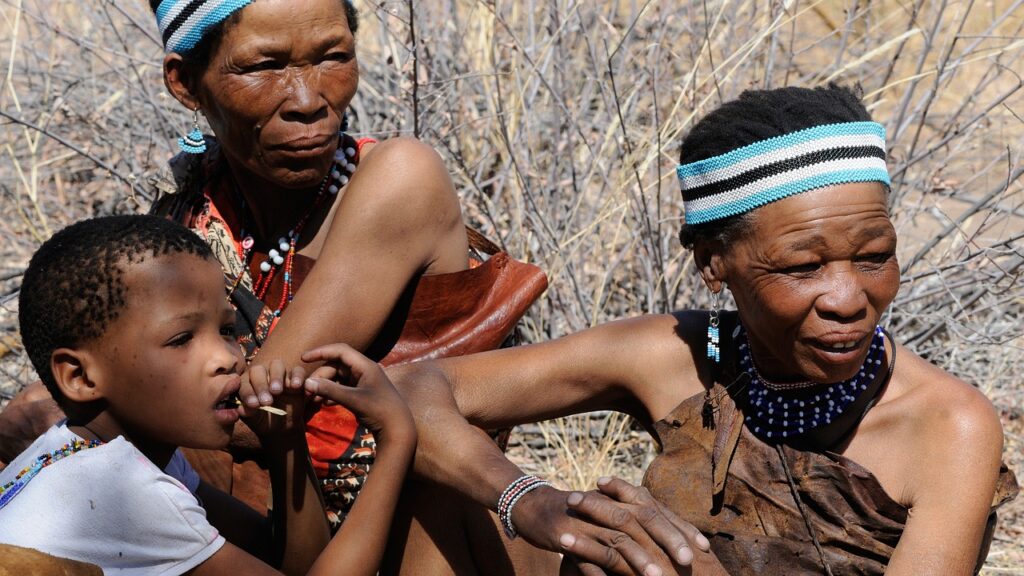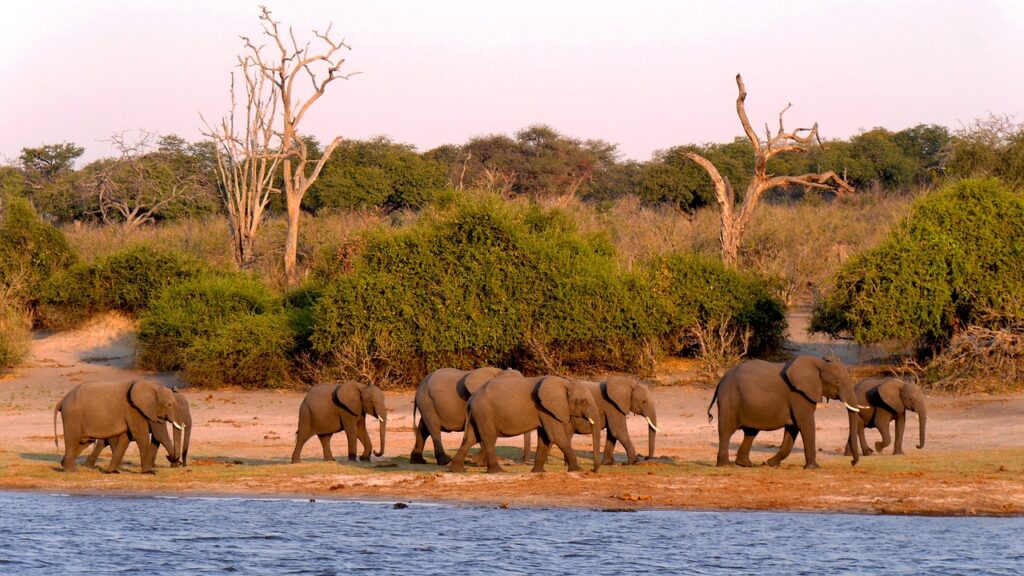Chobe National Park, located in northern Botswana, is one of Africa’s premier wildlife destinations. Known for its stunning landscapes and rich biodiversity, the park is especially famous for its large elephant population. With diverse ecosystems ranging from floodplains and forests to dry savannahs, Chobe offers a variety of habitats that support a wide array of wildlife. The park’s proximity to Kasane, a bustling town on the Chobe River, makes it easily accessible for visitors. Here’s a comprehensive guide to the best places to visit in Chobe National Park:
Best Places to Visit
1. Chobe Riverfront
The Chobe Riverfront, also known as the Serondela area, is the most popular region in Chobe National Park. It is renowned for its high concentration of wildlife, especially during the dry season when animals congregate along the river. The riverfront is famous for its large herds of elephants, which can often be seen swimming and playing in the water. Visitors can enjoy boat safaris along the Chobe River, offering a unique perspective on the wildlife and stunning scenery.
- Key Attractions: Large herds of elephants, diverse wildlife.
- Activities: Boat safaris, game drives, bird watching.
- Location: Northeastern part of Chobe National Park.
2. Savuti Marsh
Savuti Marsh, located in the southwestern part of Chobe National Park, is known for its dramatic landscapes and rich wildlife. The marsh area is famous for its predator population, including lions, leopards, and hyenas. The Savuti Channel, which occasionally flows, adds a dynamic element to the region, transforming the landscape and attracting different species. The area is also known for its ancient rock paintings created by the San people.
- Key Attractions: Predator sightings, Savuti Channel.
- Activities: Game drives, cultural exploration.
- Location: Southwestern part of Chobe National Park.
3. Linyanti Marsh
Linyanti Marsh, situated in the northwest of Chobe National Park, is a remote and less-visited area, making it ideal for those seeking a more secluded safari experience. The marsh is a haven for wildlife, including elephants, hippos, and a variety of bird species. The Linyanti River, which flows through the marsh, attracts numerous animals, particularly during the dry season. The area is also known for its large populations of wild dogs.
- Key Attractions: Remote wilderness, abundant wildlife.
- Activities: Game drives, walking safaris.
- Location: Northwestern part of Chobe National Park.
4. Nogatsaa and Tchinga
Nogatsaa and Tchinga are lesser-known regions of Chobe National Park, offering a quieter and more intimate wildlife experience. These areas are characterized by open grasslands and waterholes that attract a variety of animals, including elephants, buffaloes, and antelopes. The regions are particularly beautiful during the wet season when the waterholes are full, and the vegetation is lush. Visitors can enjoy game drives and bird watching in this serene environment.
- Key Attractions: Open grasslands, waterholes.
- Activities: Game drives, bird watching.
- Location: Central part of Chobe National Park.
5. Chobe Safari Lodge
Chobe Safari Lodge, located on the banks of the Chobe River near Kasane, is a popular accommodation option for visitors to the park. The lodge offers a range of activities, including boat safaris, game drives, and cultural tours. It provides a comfortable base for exploring Chobe National Park and enjoying the rich wildlife and natural beauty of the area. The lodge also has a restaurant, bar, and swimming pool, making it a convenient and relaxing place to stay.
- Key Attractions: Comfortable accommodation, range of activities.
- Activities: Boat safaris, game drives, cultural tours.
- Location: Near Kasane.
6. Sedudu Island
Sedudu Island, also known as Kasikili Island, is a small island located in the Chobe River. The island is known for its lush vegetation and abundant wildlife, including hippos, crocodiles, and a variety of bird species. It is a popular destination for bird watchers, as many waterfowl and migratory birds can be seen here. Visitors can explore the island on boat tours, enjoying the tranquil environment and diverse wildlife.
- Key Attractions: Bird watching, scenic landscapes.
- Activities: Boat tours, wildlife viewing.
- Location: Chobe River.
7. Chobe Floodplains
The Chobe Floodplains, located along the Chobe River, are an essential part of the park’s ecosystem. During the rainy season, the floodplains are inundated with water, attracting a wide range of wildlife. The area is known for its large herds of buffaloes and elephants, as well as numerous bird species. The floodplains offer excellent opportunities for game viewing and photography, especially during the wet season.
- Key Attractions: Seasonal floods, diverse wildlife.
- Activities: Game viewing, photography.
- Location: Along the Chobe River.
8. Impalila Island
Although technically located in Namibia, Impalila Island is easily accessible from Kasane and offers a unique perspective on the Chobe region. The island is situated at the confluence of the Zambezi and Chobe Rivers and is known for its scenic beauty and cultural significance. Visitors can enjoy fishing, bird watching, and cultural tours, as well as explore the island’s lush landscapes. Impalila Island provides a peaceful retreat with stunning views of the surrounding rivers.
- Key Attractions: Scenic beauty, cultural experiences.
- Activities: Fishing, bird watching, cultural tours.
- Location: Confluence of Zambezi and Chobe Rivers.
Summary Table
| Place | Description | Key Attraction | Distance from Main Area |
|---|---|---|---|
| Chobe Riverfront | Most popular region with large herds of elephants | Boat safaris, diverse wildlife | Northeastern Chobe |
| Savuti Marsh | Known for predators and the Savuti Channel | Lion sightings, ancient rock paintings | Southwestern Chobe |
| Linyanti Marsh | Remote area with abundant wildlife | Wild dogs, secluded experience | Northwestern Chobe |
| Nogatsaa and Tchinga | Quiet regions with open grasslands | Waterholes, bird watching | Central Chobe |
| Chobe Safari Lodge | Popular lodge offering a range of activities | Comfortable accommodation, game drives | Near Kasane |
| Sedudu Island | Lush island known for bird watching | Bird watching, scenic landscapes | Chobe River |
| Chobe Floodplains | Seasonal floodplains attracting diverse wildlife | Buffalo herds, bird species | Along the Chobe River |
| Impalila Island | Island at the confluence of two major rivers | Fishing, cultural tours | Confluence of Zambezi and Chobe Rivers |
How to Reach Chobe National Park
By Air
Kasane Airport is the main gateway for travelers visiting Chobe National Park. The airport offers flights from major cities in Botswana and neighboring countries. From Kasane Airport, visitors can easily access the park and surrounding areas by road.
By Road
Chobe National Park is accessible by road from Kasane, which is connected to other major towns in Botswana and neighboring countries. The park has well-maintained roads, making it easy to explore the different regions by car. Many visitors opt for guided tours or self-drive safaris.
By Water
The Chobe River provides an alternative route into the park, with many lodges and tour operators offering boat transfers and safaris. The river also serves as a border with Namibia, allowing for cross-border travel and exploration.
Best Time to Visit Chobe National Park
The best time to visit Chobe National Park is during the dry season, from May to October. During this period, wildlife is more concentrated along the riverbanks, making it ideal for game viewing. The wet season, from November to April, brings lush green landscapes and a variety of bird species, making it a great time for bird watching and enjoying the park’s scenic beauty.
Travel Tips
- Local Cuisine: While visiting Chobe National Park, try local Tswana dishes such as seswaa (pounded meat), morogo (wild spinach), and pap (maize porridge). Many lodges offer a mix of local and international cuisine.
- Cultural Insights: The region around Chobe is home to diverse communities with rich cultural traditions. Visitors can experience local music, dance, and crafts through cultural tours and interactions.
- Safety Tips: Chobe National Park is a wild area with dangerous animals. Always follow the guidance of your guide or lodge staff, stay inside your vehicle during game drives, and avoid walking around unaccompanied, especially at night.
Chobe National Park is a must-visit destination for wildlife enthusiasts and nature lovers. With its diverse landscapes, abundant wildlife, and rich cultural experiences, the park offers something for everyone. Whether you’re cruising along the Chobe River, exploring the remote Savuti Marsh, or enjoying the tranquility of the Linyanti Marsh, Chobe National Park promises an unforgettable adventure in the heart of Botswana’s wilderness.












